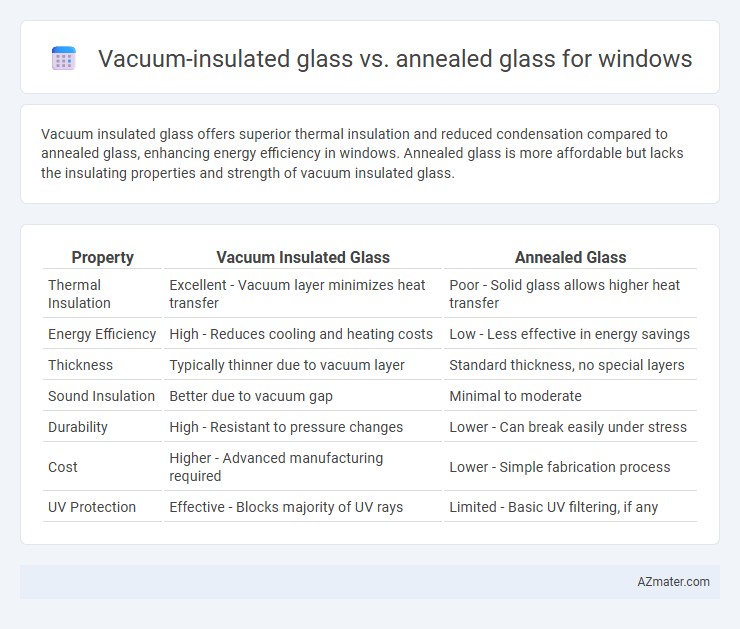Vacuum insulated glass offers superior thermal insulation and reduced condensation compared to annealed glass, enhancing energy efficiency in windows. Annealed glass is more affordable but lacks the insulating properties and strength of vacuum insulated glass.
Table of Comparison
| Property | Vacuum Insulated Glass | Annealed Glass |
|---|---|---|
| Thermal Insulation | Excellent - Vacuum layer minimizes heat transfer | Poor - Solid glass allows higher heat transfer |
| Energy Efficiency | High - Reduces cooling and heating costs | Low - Less effective in energy savings |
| Thickness | Typically thinner due to vacuum layer | Standard thickness, no special layers |
| Sound Insulation | Better due to vacuum gap | Minimal to moderate |
| Durability | High - Resistant to pressure changes | Lower - Can break easily under stress |
| Cost | Higher - Advanced manufacturing required | Lower - Simple fabrication process |
| UV Protection | Effective - Blocks majority of UV rays | Limited - Basic UV filtering, if any |
Introduction to Vacuum Insulated Glass and Annealed Glass
Vacuum insulated glass (VIG) consists of two glass panes separated by a vacuum layer, significantly reducing heat transfer and enhancing energy efficiency in windows. Annealed glass is a standard, slowly cooled glass that provides basic clarity and strength but lacks advanced insulating properties. VIG's superior thermal performance makes it ideal for energy-saving window applications, whereas annealed glass is commonly used in less demanding environments due to its cost-effectiveness.
Understanding the Structure and Composition
Vacuum insulated glass (VIG) consists of two glass panes separated by a narrow vacuum gap, eliminating conductive and convective heat transfer, with a durable edge seal maintaining the vacuum and metal spacers supporting structural integrity. Annealed glass, by contrast, is a single, uniform sheet of slowly cooled glass without specialized internal layers or insulation, making it more prone to heat transfer and thermal stress. The advanced structure of VIG provides superior thermal insulation and energy efficiency compared to the simple, homogenous composition of annealed glass, which primarily serves as a basic glazing material.
Thermal Performance Comparison
Vacuum insulated glass (VIG) offers superior thermal performance compared to annealed glass due to its near-complete elimination of conductive and convective heat transfer within the insulating space. The vacuum gap in VIG significantly reduces heat loss, resulting in lower U-values typically around 0.5 W/m2K, whereas annealed single-pane glass has U-values approximately 5.7 W/m2K. This enhanced insulation capability of vacuum insulated glass contributes to increased energy efficiency and improved indoor comfort in building windows.
Energy Efficiency Benefits
Vacuum insulated glass (VIG) offers superior energy efficiency compared to annealed glass by significantly reducing heat transfer through its vacuum-sealed space, minimizing convection and conduction. This advanced technology enhances thermal insulation, leading to lower heating and cooling costs and improved indoor comfort in both residential and commercial windows. Annealed glass, lacking this insulating vacuum layer, allows greater heat loss, making VIG the preferred choice for sustainable, energy-conscious building designs.
Sound Insulation Capabilities
Vacuum insulated glass (VIG) offers superior sound insulation compared to annealed glass due to the vacuum layer between panes that minimizes sound wave transmission. Annealed glass, being a single solid pane, lacks this airless cavity, resulting in higher noise penetration. For windows in noisy environments, VIG significantly reduces external noise pollution, enhancing acoustic comfort indoors.
Durability and Lifespan
Vacuum insulated glass (VIG) offers superior durability compared to annealed glass due to its robust construction with a vacuum-sealed space that resists thermal stress and reduces condensation. Annealed glass, while cost-effective, is more prone to breakage and has a shorter lifespan because it lacks reinforcement against impact and temperature fluctuations. VIG typically lasts 20-30 years or more under normal use, whereas annealed glass may require replacement within 10-15 years depending on environmental conditions.
Safety and Security Features
Vacuum insulated glass (VIG) significantly enhances window safety and security by combining two glass panes separated by a vacuum, providing superior impact resistance and reduced risk of shattering compared to traditional annealed glass. Unlike annealed glass, which is prone to breakage and shatters into sharp shards, vacuum insulated glass maintains structural integrity under stress, offering better protection against forced entry and accidents. The advanced design of VIG also improves thermal performance, reinforcing the window's overall durability and security features.
Installation Requirements and Considerations
Vacuum insulated glass requires precise, airtight installation techniques to maintain the vacuum seal and ensure thermal efficiency, often necessitating specialized framing and careful handling to avoid damage. Annealed glass is simpler to install, compatible with standard window frames, and less sensitive to pressure changes or vacuum integrity. Proper consideration of installation environment and hardware compatibility is critical for vacuum insulated glass, while annealed glass offers more flexibility with conventional construction practices.
Cost Analysis and Value for Money
Vacuum insulated glass (VIG) typically commands a higher upfront cost compared to annealed glass due to its advanced technology and superior insulating properties, which significantly reduce energy consumption over time. Annealed glass, while more affordable initially, lacks the thermal efficiency of VIG, potentially leading to higher heating and cooling expenses. Investing in VIG delivers greater long-term value for money by enhancing energy savings, thermal comfort, and durability, making it a cost-effective solution despite the higher initial investment.
Ideal Applications for Each Glass Type
Vacuum insulated glass (VIG) excels in energy-efficient building applications requiring superior thermal insulation, such as passive houses, commercial high-rises, and cold-climate residential windows, due to its exceptional U-value typically around 0.5 W/m2K. Annealed glass is ideal for applications where cost-effectiveness and basic safety are prioritized, including standard residential windows and interior glazing, but it lacks the thermal performance and structural strength needed for high-performance or safety-critical installations. Selecting vacuum insulated glass supports stringent energy codes and sustainability goals, while annealed glass suits traditional construction needs with lower upfront costs.

Infographic: Vacuum insulated glass vs Annealed glass for Window
 azmater.com
azmater.com